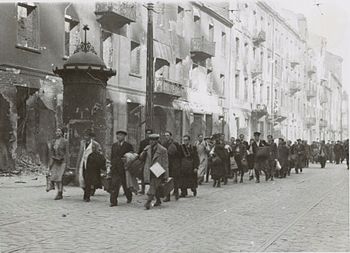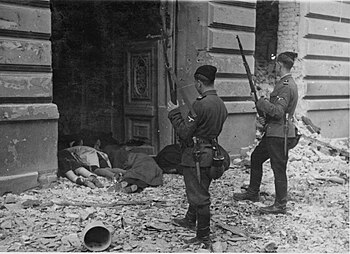|
The Warsaw Ghetto Uprising 1943
“If you fight, you may lose. If you don’t fight, you have already lost”
The Jews living in the Ghetto in Warsaw faced a threat that made any resistance and fighting appear useless. Four weeks after the German Army’s first assault on Poland the first units reached Warsaw, where more than 380.000 Jews were living at that time. It soon became clear. That there was not much hope for them. From then on, people of Jewish faith were not only excluded and discriminated against, but also subjected to terrible living conditions. On 2 October 1940 the order was given to create a ghetto, and soon a city inside the city behind existed high walls in Warsaw. A lethal lack of provisions, of space and forced labour now dominated the lives of those imprisoned in the ghetto,
which soon was cruelly overcrowded with up to 450.000 people forced to live on 3.1 km2. If the German district Haßberge (where the German pupils live) had this population density, it would have to hold about 140 million people – (half the population of the Russian Federation) - instead of the 85.000 inhabitants it now has.
In many descriptions of the holocaust the Jews appear as passive audience of their own sufferings, who had no way of resisting the German attacks and atrocities. In the course of what the Nazis used to call the “final solution to the Jewish question” the deportations of those living in the ghetto to the death camp in Treblinka – located north of Warsaw – began. Within three months about 240.000 Jews were thus displaced and murdered.
The remaining inhabitants of the ghetto decided to set a sign – a sign that would show the world that the Jews would not surrender without fighting. On 19 April 1043 those remaining in the ghetto rebelled against the SS-formations that had moved in to drive out the remaining inhabitants – expecting no resistance at all. Poorly armed, outnumbered and in a hopeless position very soon, the fighters of the organization „Zydowska Organizacja Bojowa“ and other Jewish fighting units still held out almost for a full month against the occupying forces, before the fighting ended on 16 May 1943. The remaining buildings in the former ghetto were burned down or blown up by the Germans and only a few former inhabitants of the ghetto survived.
 
To realize how important this example of Jewish resistance is today, it is enough to go to Warsaw on April 19, as every year on this day people wear yellow daffodils to commemorate the Warsaw ghetto uprising and the victims of the holocaust.
by Nico Hofmann, Q11
|